Join More Than 50,000+ Subscribers and get latest camera news and rumors
NEW CAMERA VIDEOS ON YOUTUBE
|
By admin, on June 22nd, 2016
The recently announced Hasselblad X1D camera features High quality Sony sensor, new menu navigation system with full touch control and a ultra-compact & portable design. Take a look at the size comparison of Hasselblad X1D vs Leica Fullframe mirrorless vs Fuji X-Pro 2 vs Nikon D800E
Hasselblad X1D vs. Nikon D800E vs Leica SL vs. Fuji X-pro 2 – Image Size Comparison
Hasselblad X1D vs Nikon D800E
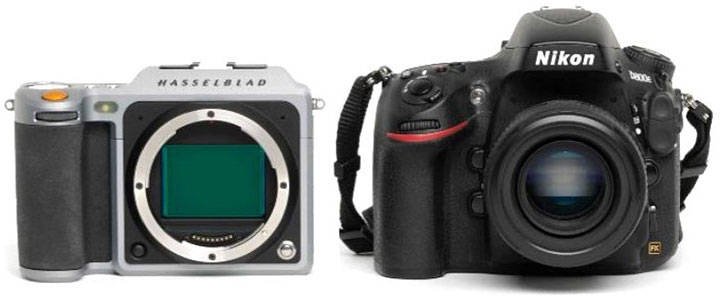
The Hasselblad X1D vs Nikon D800E – If we look at both the camera it is very clear that Hasselblad X1D camera is not bigger than Nikon D800E, but at the same time if you look at the sensor size and dramatically larger lens-mount ring of X1D you can imagine the amount of effort Hasselblad team added to this project to make the system size portable, light weight and compact.
Hasselblad X1D vs Fuji X-Pro2
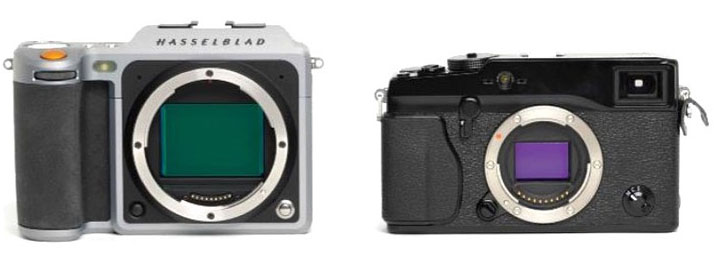
The difference in sensor size and body size of both the camera does look in proportion ? Fuji need to do some R&D in reducing the body fat of camera body 🙂
Hasselblad X1D vs Leica SL
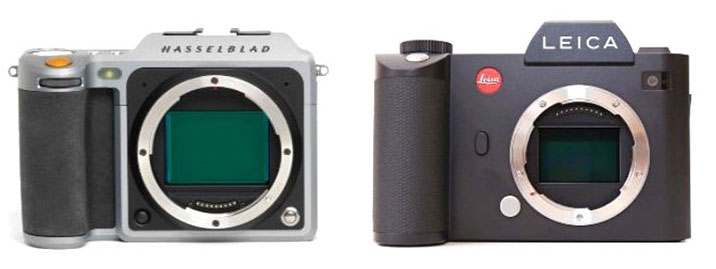
And finally Leica killer has arrived ? – Both, Leica and Hasselblad strike a very specific market of pro-photographers with pocket full of cash. But I think a large number of Leica users including Steve Huff will going to try hands on X1D. The Hasselblad X1D is a perfect machine with High quality Sony MF sensor inside it, that will sure going to surpass the performance of Leica fullframe mirrorless cameras.
By admin, on June 12th, 2016
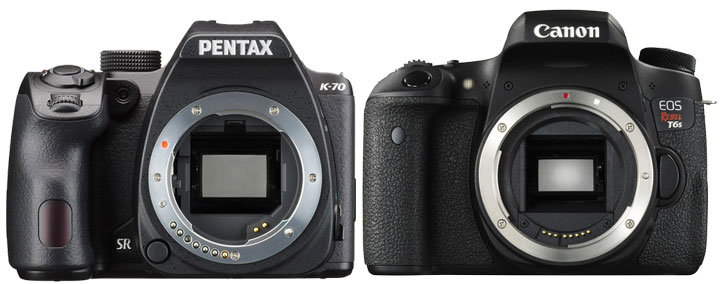 We have selected Canon 760D with Pentax K-70 take a look at the specification comparison review of both the camera and do share your thoughts with us. We have selected Canon 760D with Pentax K-70 take a look at the specification comparison review of both the camera and do share your thoughts with us.
Before we begin you must know that Pentax K 70 is announced by Pentax on June 10th 2016 and it arrived a bunch of new features for example it is the first mid-range Pentax camera features ISO range upto 102400 the other major feature that has been included in the Pentax DSLR is the introduction of hybrid out of AF system that combines Phase detection autofocus + contrast detection auto focus system. You want to know more about the new features of the recently announced Pentax camera click here
Take a look at the specification comparison between Pentax K-70 vs Canon 760D
| Features/ Models |
Pentax K-70
|
Canon 760D
|
| Sensor |
24 megapixels |
24 megapixels |
| Sensor size |
APS-C (23.5 x 15.6 mm) |
APS-C (22.3 x 14.9 mm) |
| Sensor Type |
CMOS |
CMOS |
| Image stabilization |
Sensor-shift |
No built in image stabilization |
| Low pass filter |
Yes |
Yes |
| Image processor |
PRIME MII |
DIGIC 6 |
| AF system |
Phase detect +Contrast detect
|
Phase detect + Contrast detect |
| AF points |
11 |
19 |
| ISO |
Auto, 100-102400 |
100-25600 |
| Shutter Min/ mix |
1/6000 – 60 |
1/4000 – 30 |
| Continuous shooting speed |
6fps |
5fps |
| Video |
Full HD 1080p Video at up to 60 fps |
Full HD 1080p Video at up to 30 fps |
| Display |
3.0″ 921k-Dot Vari-Angle Touchscreen |
3.0″ 1.04m-dot Vari-Angle Touchscreen |
| Viewfinder |
2.36m-Dot OLED Electronic Viewfinder |
3″ Pivoting Touchscreen LCD (1,040,000) |
| Hot shoe |
Yes |
Yes |
| Wireless |
Built-In Wi-Fi |
Built-In Wi-Fi |
| Environmentally sealed |
Yes |
No |
| Battery life |
410 |
440 |
| Dimensions |
126 x 93 x 74 mm
|
132 x 111 x 78 mm |
| Weight |
688 g |
565 g |
Both the camera features same sensor size and image resolution, however the architecture of both the sensor are entirely different. The Canon 760D camera features Hybrid CMOS AF sensor made by Canon and on the other side we have Pentax K-70 camera that us using 24 Megapixel sensor made by Sony.
Penatx K-70 camera and Canon 760D camera AF system
Both camera uses Hybrid AF CMOS sensor hence you will get fast AF while shooting still or video with both the camera.
Pentax K-70 features better low-light sensitivity.
The Pentax K70 features better low-light sensitivity compared to the Canon 760D camera, the canon 760D remains limited to ISO 25600 on the other hand the Pentax K-70 camera can boost its ISO sensitivity upto 102400.
However, we have didn’t seen any HIGH ISO test between these two camera, if we believe the specification sheet of Pentax the we are sure that Pemtax will perform better during low light condition compared to Canon 760D camera.
other better features compared to Canon 760D
The other better features inside the Pentax K-70 camera, it comes with fast continuous shooting speed, improved shutter speed and better video recording capabilit inisde the Pentax K-70 camera.
Verdict: The Pentax K-70 camera features better sensor with more low light sensitivity as well as it also allow you to record Full HD video at 60fps per second. based on specification comparison we highly recommend you to buy the Pentax K70 DSLR camera.
Take a look the list of new features arrived with the Pentax K-70 camera.
Buy Pentax K-70 Camera from Amazon | B&H
Buy Canon T6S from Amazon
By admin, on May 24th, 2016
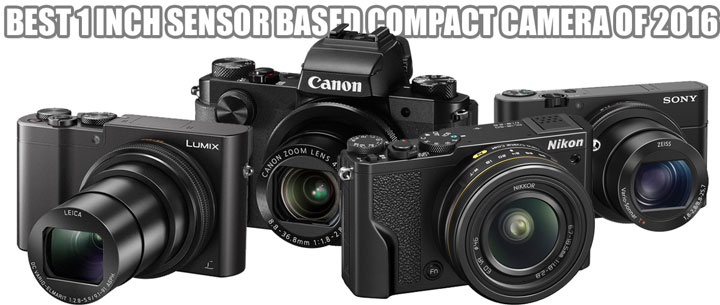
Take a look at the specification between the on of the best compact camera announced in 2016, our list includes Panasonic ZS100 vs Sony RX100 IV vs Nikon DL 18-50 vs Canon G5X.
We are starting with Panasonic ZS1 camera, the camera also features 1″ sensor , all camera in the list features same size sensor although the sensor makers of all cameras are bit different
Sony RX100 IV is developed by Sony itself, it uses stacked CMOS technology to give more details and less noise compared to competitors the same sensor is also used inside the Sony RX10 III camera. The Canon G3X uses same sensor as of Sony RX100 III camera, the Nikon is best of all and is used Nikon j5 sensor inside the Nikon DL series camera, the Nikon DL 18-50mm is the only camera in the list that supports hybrid Auto Focus none of the camera till now features Hybrid AF system.
4K Post Focus photo capture features enables you to shoot first and focus later facility just as Lytro camera, no such feature available in any of the competitors.
Panasonic ZS1 vs Sony RX100 MIV
| Features/ Models |
Panasonic ZS1 |
Sony RX100 MIV |
| Megapixel |
20.1 Megapixel |
20.1 MP |
| Sensor size |
1″ BSI-CMOS Sensor |
1″ BSI-CMOS Sensor |
| Low pass filter |
NA |
Yes |
| Image processor |
Venus Engine Image Processor |
BIONZ X |
| Image Stabilization |
5-Axis Hybrid O.I.S. |
Optical SteadyShot |
| Optical Zoom |
10X |
2.9X |
| AF system |
Contrast Based |
Contrast Based |
| ISO |
80-25600 |
80-12800 |
| Shutter Min/ mix |
60-1/16000s |
30-1/16000s |
| Continuous shooting speed |
50 fps |
16 fps |
| Video |
4K 30fps |
4K 30fps |
| Display |
3.0″ LCD Rear Touch Screen (1,040,000 pixels) |
3″ Tilting Screen |
| Viewfinder |
1166k dot Electronic viewfinder |
2359k dot Electronic viewfinder |
| Battery Life |
300 shots |
|
| Wireless |
Built-In Wi-Fi |
Built-In Wi-Fi Connectivity with NFC |
| Environmentally sealed |
No |
No |
| Dimensions |
312g. 111 x 65 x 44 mm |
101.6 x 61.0 x 40.6 mm |
Panasonic ZS100 vs Sony RX100 IV, many photographers ask the same question which camera should I purchase ? RX100 IV or ZS1… so I am here to do a quick analysis for you. The Sony
Both the camera uses same size sensor however the ISO range of Sony is less compared to Panasonic, that clearly means Panasonic will give you better low-light performance compared to Sony RX100 IV.
Panasonic features better image stabilization compared to Sony RX100 N IV camera, the Panasonic comes with a 5 axis image stabilization system whereas the Sony RX100 IV limited to optical steady shot IS only.
Panasonic features blazing fast shooting speed compared to Sony. Panasonic ZS1 can capture 50 frames per second on the other hand the Sony last up to 16 fps only.
Known issues: Sony RX100 MI V overheating issue reported while recording 4K video, the issue can be solved by adding heat sink plates to the sensor
Buy Panasonic ZS 1 from Amazon | B&H
Buy Sony RX100 M4 Camera from B&H and Amazon
Panasonic ZS1 vs Nikon DL 18-50
| Features/ Models |
Panasonic ZS1 |
Nikon DL 18-50 |
| Megapixel |
20.1 Megapixel |
20.8MP |
| Sensor size |
1″ BSI-CMOS Sensor |
1″ CX-Format BSI CMOS Sensor |
| Low pass filter |
NA |
No |
| Image processor |
Venus Engine Image Processor |
EXPEED 6A |
| Image Stabilization |
5-Axis Hybrid O.I.S. |
Dual Detect VR |
| Optical Zoom |
10X |
|
| AF system |
Contrast Based |
Hybrid AF System with 171 Focus Points |
| ISO |
80-25600 |
160-12800 |
| Shutter Min/ mix |
60-1/16000s |
30- 1/16000 |
| Continuous shooting speed |
50 fps |
60fps |
| Video |
4K 30fps |
4K 30fps |
| Display |
3.0″ LCD Rear Touch Screen (1,040,000 pixels) |
3″ Tilting Screen |
| Viewfinder |
1166k dot Electronic viewfinder |
Electronic |
| Battery Life |
300 shots |
290 shots |
| Wireless |
Built-In Wi-Fi |
Wi-Fi, NFC, & Bluetooth Connectivity |
| Environmentally sealed |
No |
No |
| Dimensions |
312g. 111 x 65 x 44 mm |
106.0 x 63.0 x 57.5 mm |
Nikon DL 18-50mm is the only camera with 1″ sensor that features Hybrid AF system, hence un-doublty the DL will do fastest AF among all the other compact camera of its range.
On the other side we have Panasonic SZ1 camera that features bit better ISO range, more shutter speed and better image stabilization system.
At the end if we look at the specification comparison table we see Panasonic ZS1 more good compared to the Nikon DL 18-50, however if you need more fast AF you must go with Nikon DL 18-50.
Buy Panasonic ZS 1 from Amazon | B&H
Nikon DL 18-50mm from Amazon | B&H
Panasonic ZS1 vs Canon G3X
| Features/ Models |
Panasonic ZS1 |
Canon G5X |
| Megapixel |
20.1 Megapixel |
20MP |
| Sensor size |
1″ BSI-CMOS Sensor |
1″ BSI-CMOS Sensor |
| Low pass filter |
NA |
Yes |
| Optical Zoom |
10X |
4.2X |
| Image processor |
Venus Engine Image Processor |
DIGIC 6 Image Processor |
| Image Stabilization |
5-Axis Hybrid O.I.S. |
Optical |
| AF system |
Contrast Based |
Contrast based |
| ISO |
80-25600 |
125 – 12800 |
| Shutter Min/ mix |
60-1/16000s |
30-1/2000 |
| Continuous shooting speed |
50 fps |
5.9 fps |
| Video |
4K 30fps |
1920 x 1080 video resolution |
| Display |
3.0″ LCD Rear Touch Screen (1,040,000 pixels) |
3″ Fully Articulated Screen |
| Viewfinder |
1166k dot Electronic viewfinder |
2360k dot Electronic viewfinder |
| Battery Life |
300 shots |
210 shots |
| Wireless |
Built-In Wi-Fi |
Built-In Wi-Fi Connectivity with NFC |
| Environmentally sealed |
No |
No |
| Dimensions |
312g. 111 x 65 x 44 mm |
353g. 112 x 76 x 44 mm |
Panasonic ZS1 vs Canon G3X. The Canon G3X features same sensor size and resolution as of Panasonic ZS1 although we have a lot of difference among them.
The Pansonic ZS1 features better image stabilization system compared to Canon G3X camera, the 5 axis based Image stabilization system helps to combat camera shakes and manage slower shutter speed upto 4.5 stops.
The ISO range of the the camera is better than Canon G5X, the Panasonic ZS1 features ISO range upto 25600 on the other hand the Canon G5X camera is limited to 12800.
The biggest advantage of Panasonic ZS100 is that it can shoot 4K video at 30fps on the other hand the Canon G3X remains limited to shooting Full HD videos only.
Buy Panasonic ZS 1 from Amazon | B&H
Buy Canon G5X from B&H and Amazon
By admin, on April 27th, 2016
 We have already published Nikon D500 first High ISO Test here, Now today the High ISO test published at dpreview website. The camera is delivering excellent results during the test. We have compared Nikon D500 vs. Nikon D750 vs. Nikon D810 vs Nikon D7200 on a single line of frame and surprisingly the Nikon D500 camera is giving excellent image quality compared to the three in-home competitors (two of them are full-frame camera). We have already published Nikon D500 first High ISO Test here, Now today the High ISO test published at dpreview website. The camera is delivering excellent results during the test. We have compared Nikon D500 vs. Nikon D750 vs. Nikon D810 vs Nikon D7200 on a single line of frame and surprisingly the Nikon D500 camera is giving excellent image quality compared to the three in-home competitors (two of them are full-frame camera).
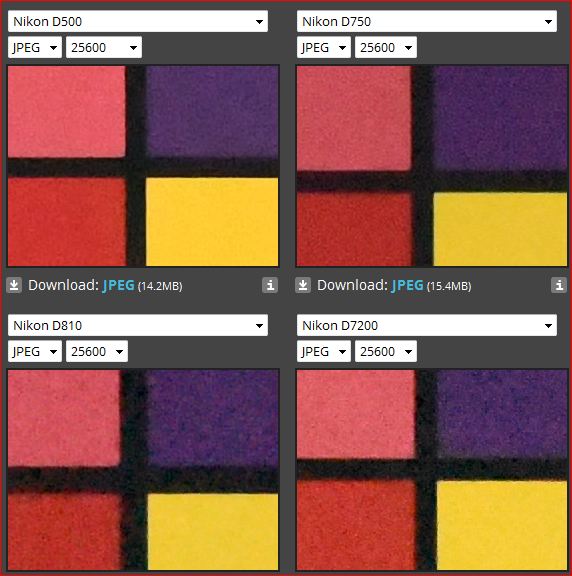
Despite of having a APS-C sensor the Nikon D500 giving strong competition to Nikon D750 fullframe camera and showing better result than Nikon D810 and Nikon D7200 camera.
After looking at the High ISO test of all the four camera take look at the specification comparison of all the four camera. The Nikon D500 features advance Expeed 5 image processor, more ISO range compared to all the three competitors and advance AF system support with 153 AF points that covers the entire frame of the camera helps you to shoot and track your subjects in not time. The continuous shooting spored of the camera is also very impressive (10 fps @ 20.9 MP) and finally the D500 is able to record 4K videos @ 30fps upto 30 mins and all the three of them remains limited to Full HD mode only.
Nikon D500 vs. Nikon D750 vs. Nikon D810 vs Nikon D7200
| Features |
Nikon D500 |
Nikon D750 |
Nikon D810 |
Nikon D7200 |
| Sensor |
20.9MP DX-Format CMOS Sensor |
24.3MP FX-Format CMOS Sensor |
36.3MP FX-Format CMOS Sensor |
24.2MP DX-Format CMOS Sensor |
| Image Processor |
EXPEED 5 Image Processor |
EXPEED 4 Image Processor |
EXPEED 4 Image Processor |
EXPEED 4 Image Processor |
| ISO |
Native ISO 51200, Extend to ISO 1640000 |
Native ISO 12800, Extended to ISO 51200 |
Native ISO 12800, Extended to ISO 51200 |
Native ISO 25600, B&W to ISO 102400 |
| AF System |
Multi-CAM 20K 153-Point AF System |
Multi-CAM 3500FX II 51-Point AF Sensor |
Multi-CAM 3500 FX 51-Point AF Sensor |
Multi-CAM 3500 II DX 51-Point AF Sensor |
| Continuous shooting speed |
10 fps Shooting for Up to 200 Frames |
Continuous Shooting Up to 6.5 fps |
5 fps Shooting at Full Resolution |
6 fps Shooting for Up to 100 Frames |
| Video |
4K UHD Video Recording at 30 fps |
Full HD 1080p Video Recording at 60 fps |
Full HD 1080p Video at 60/30/24 fps |
Full HD 1080p Video Recording at 60 fps |
| Display |
3.2″ 2,539k-Dot Tilting Touchscreen LCD |
3.2″ 1,229k-Dot RGBW Tilting LCD Monitor |
3.2″ 1,229k-Dot LCD Monitor |
3.2″ 1,229k-Dot LCD Monitor |
| Wireless |
Built-In Wi-Fi, Bluetooth and NFC |
Built-In Wi-Fi Connectivity |
NA |
Built-In Wi-Fi Connectivity with NFC |
From the specification comparison it is very clear that Nikon D500 showing excellent core specification despite of having a smaller APS-C sensor compared to Nikon D750 and Nikon D810.
If you are planning to buy your next Nikon camera We highly recommend you to go with Nikon D500 camera, it’s the best camera in Nikon line-up after Nikon D5.
Buy Nikon D500 from B&H shop and Amazon.com.
Also see – Best Lenses for Nikon D500 | More News Related to Nikon D500
High ISO Test image credit: dpreview
By admin, on April 25th, 2016
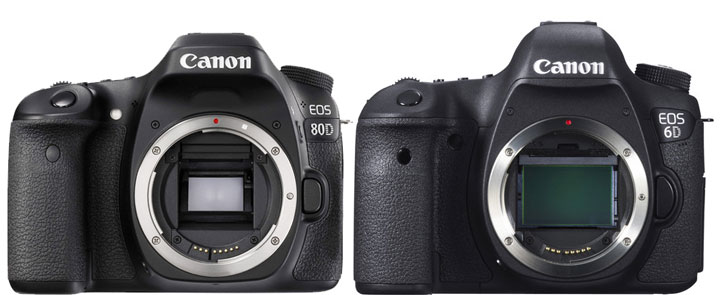 Which camera should you buy ? Canon 80D or Canon 6D ?, Well we have done a detailed specification comparison review with High ISO test, to fine out the best camera for you. Which camera should you buy ? Canon 80D or Canon 6D ?, Well we have done a detailed specification comparison review with High ISO test, to fine out the best camera for you.
| Features/ Models |
Canon 80D |
Canon 6D |
| Megapixel |
24.2MP APS-C CMOS sensor |
20.2 megapixels |
| Sensor size |
APS-C – 22.5 x 15 mm |
Full frame (36 x 24 mm) |
| Low pass filter |
No |
No |
| Image processor |
DIGIC6 |
Digic 5+ |
| Image Stabilization |
No |
No |
| AF system |
45 points (all points cross type) |
11 Point AF |
| ISO |
100-16000 Standard and 100-25600 Expandable |
100 – 25600 in 1/3 stops, plus 50, 51200, 102400 as option |
| Shutter Min/ mix |
30 -1/8000 |
30 sec- 1/4000 sec |
| Continuous shooting speed |
7fps |
4.5 |
| Video |
Full HD 60fps |
Full HD 30fps |
| Display |
3 inches 1.04 million dot Vari-angle LCD |
3.2″ 2,539k-Dot LCD Display |
| Viewfinder |
Optical |
Optical |
| Hot shoe |
Yes |
Yes |
| Wireless |
Wi-Fi, NFC. Remote shooting |
Built-In Wi-Fi |
| Environmentally sealed |
Yes |
No |
| Dimensions |
139.0 x 105.2 x 78.5mm |
145 x 111 x 71 mm |
| Weight |
730g |
770 g |
Sensor size difference:
 As you can see the sensor size of Canon fullframe camera vs Canon APS-C camera, large sensor will gather more light compared to the APS-C sensor resulting more details and better nosie performance. As you can see the sensor size of Canon fullframe camera vs Canon APS-C camera, large sensor will gather more light compared to the APS-C sensor resulting more details and better nosie performance.
Advance AF system inside the Canon 80D camera: Canon 80D features advance AF system compared to Canon 6D camera.
The Canon 80D uses Dual AF system – 1. Phase AF module inside the camera and 2. Dual pixel CMOS AF sensor. The Canon 80D uses Dual pixel CMOS AF Sensor and Phase AF Module with 45 Point AF (all cross type), on the other side we have Canon 6D and it features 11 Point AF system only.
The other major difference is the use of Hybrid CMOS AF sensor inside the Canon 80D camera and with the help of the Hybrid Sensor the camera can do Blazing fast AF while shooting in live-view mode or Video mode. However, since the camera uses traditional contrast detect sensor the camera uses contrast AF system while shooting in live-view or video mode.
Fast Continuous shooting speed featured by Canon 80D camera, while having more resolution and the Canon 80D features fast continuous shooting speed compared to Canon 6D camera.
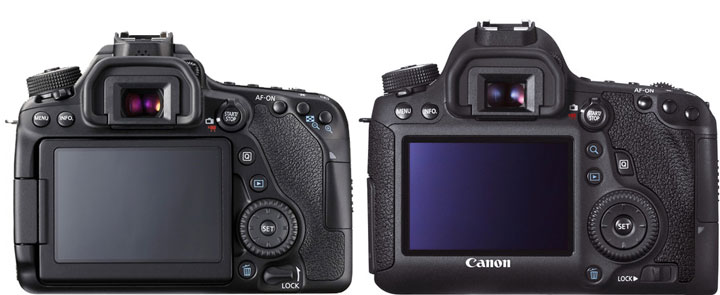 Canon 80D offers vari-angle LCD screen, Canon 6D features fixed LCD display. Better Video mode in Canon 80D camera: Canon 80D camera features Full HD video recording @ 60 frames per second on the other hand the Canon 6D is Full HD video mode is limited to 30frames per second.
The other biggest difference in the video mode of both the camera is AF speed, with the help of Dual Pixel CMOS AF technology the Canon 80D camera is able to do balzing fast AF during video mode and on the other side we have Canon 6D camera with traditional CMOS Sensor that uses slow and sluggish contrast detect AF system while recording a Video.
For sports shooter and videographers we recommend Canon 80D camera.
TIP: Best Lenses for Canon 80D DSLR
The High ISO test between the Canon 80D and Canon 6D camera clearly shows the difference between the image quality of both the camera.
High ISO Test
Canon 80D vs Canon 6D High ISO Test [ Click here to Jump on Verdict]
Canon 80D @ ISO 1600 |
Canon 6D @ ISO 1600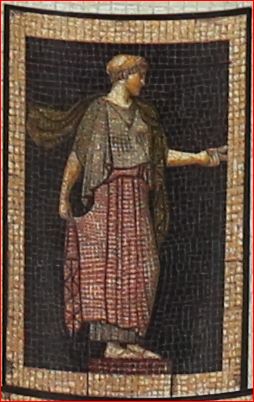 |
Canon 80D ISO @ ISO 6400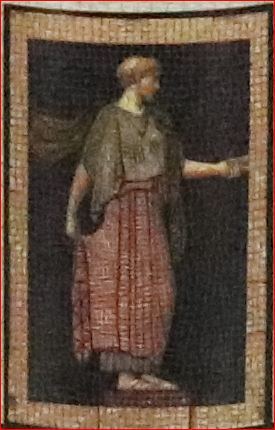 |
Canon 6D @ ISO 6400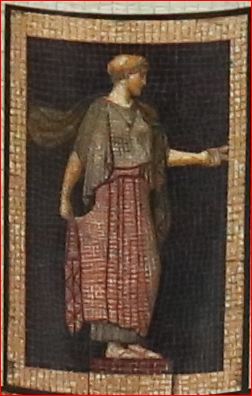 |
Canon 80D @25600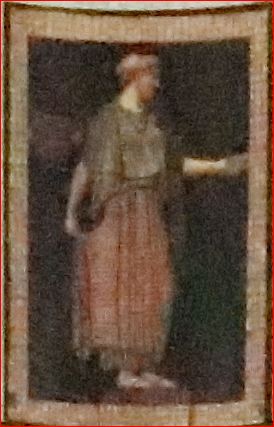 |
Canon 6D @ ISO 25600 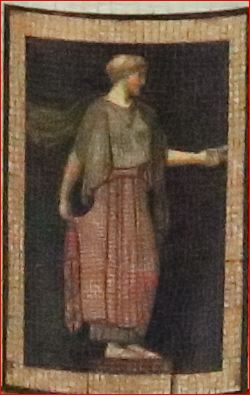 |
Image quality analysis: Starting from the ISO 25600 the difference is clearly visible, the Canon 80D image is un-usable. At ISO 6400 Canon 6D showing flawless image with super details and clarity on the other side the Canon 80D look bit fuzzy. You can look at the images of both camera at ISO 1600, Canon 6D still clearly wins. Undoubtedly Canon 6D delivers better image quality compared to Canon 80D.’
Verdict:
For still shooter who looking for image quality only we highly recommend you to get Canon 6D camera.
Spend $500 more and get a Canon 6D, It’s a is a better camera compared to Canon 80D. The bigger fullframe sensor inside the Canon 6D gives out more details compared to Canon 80D smaller sensor as you can see in the High ISO test images of both the camera. The photodiodes inside the Canon 6D camera is also bigger, since despite of having smaller sensor area the Canon 80D features 19% more pixels and due to the more pixel density the light gathering capability of every single pixel drops dramatically.
Buy Canon 6D camera from Amazon | B&H | Buy Canon 80D camera Amazon || from B&H
Image credit – Imagineresource
By admin, on April 2nd, 2016
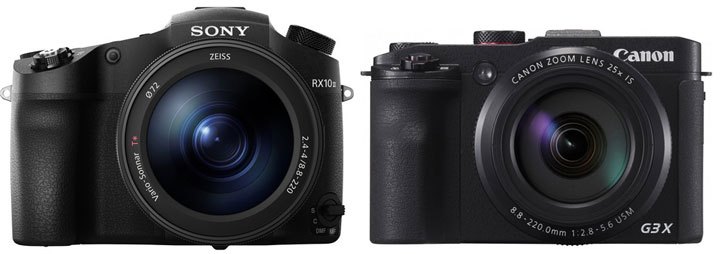 Sony RX10 III and Canon G3X features same size of 1″ sensor , but the do have some variations in the core specification, let’s find out. Sony RX10 III and Canon G3X features same size of 1″ sensor , but the do have some variations in the core specification, let’s find out.
Sony RX10 III vs. Canon G3X – Specification Comparison
| Features/ Models |
Sony RX10 III
|
Canon G3X |
| Megapixel |
20 megapixels |
20 megapixels |
| Sensor size |
1″ (13.2 x 8.8 mm) |
1″ (13.2 x 8.8 mm) |
| Optical Zoom |
25X |
25x |
| Aperture range |
F2.4 – F4.0 |
F2.8 – F5.6 |
| Macro Range |
3 cm |
5cm |
| Image processor |
Bionz X |
DIGIC 6 |
| Image Stabilization |
Optical |
Optical |
| AF system |
Contrast Detect |
Contrast Detect |
| AF Points |
25 AF points |
31 AF points |
| ISO |
Auto, 125 – 12800 (expands to 64-25600) |
Auto, 125-12800 (expands to 25600) |
| Shutter Min/ mix |
30-1/32000 |
30 – 1/2000 |
| Continuous shooting speed |
14 fps |
5.9 fps |
| Video |
4K @ 30Fps |
1920 x 1080 (60p), 1280 x 720 (30p), 640 x 480 (30p) |
| Display |
3.0″ 1.228m-Dot Tilting Xtra Fine LCD |
3.2″ tilting 1620k TFT LCD screen |
| Viewfinder |
Electronic |
Electronic |
| Hot shoe |
Yes |
Yes |
| Wireless |
WiFi and NFC |
with NFC |
| Battery life |
420 Shots |
300 shots |
| Dimensions |
133 x 94 x 127 mm |
123 x 77 x 105 mm of |
| Weight |
1051 g g |
733 g |
Sensor
Both camera does feature 20MPO 1″ sensor , but if we look in details we will find the difference from beginning. The Sony RX10 III features a 20.1MP 1″ Exmor RS CMOS sensor, which utilizes both back-illuminated and stacked technologies on the other side we have Canon G3X camera that uses a traditional 20 MP CMOS sensor and it is still unconfirmed that it uses BSI back-illuminated technology or not, however the ISO range of both the camera is same and we can’t comment on image quality until we see High ISO test between these two camera.
| Sony RX10 III |
Canon G3X |
| 1″ (13.2 x 8.8 mm) CMOS |
1″ (13.2 x 8.8 mm) CMOS |
| Utilizes both back-illuminated and stacked technologies |
back-illuminated (unconfirmed) |
Still Images: JPEG, RAW
Movies: AVCHD Ver. 2.0, MP4, XAVC S |
Still Images: JPEG, RAW
Movies: MPEG-4 AVC/H.264 |
Lens:
The Aperture Range: We can clearly see that Sony RX10 II lens is 0.04 stop brighter than the G3X, that will sure create a noticeable difference under test environment.
Capture better Macro with Sony RX10 III – The Sony RX10 III allows you to go more closer to ur subject, the Sony RX10 III features macro closeup ramge of 3cm on the other side the Canon G3X is limited to 5cm of macro closeup.
Take a look at the table for lens specification comparison
| Sony RX10 III |
Canon G3X |
| Optical: 25x |
Optical: 25x |
| Clear Image Zoom: 2x |
Digital: 4x |
| Digital: 4x |
|
| EFL: 8.8-220mm (35 mm equivalent: 24-600mm) |
EFL: 8.8-220mm (35 mm equivalent: 24-600mm) |
| Carl Zeiss Vario-Sonnar, 18 elements in 13 groups 6 Aspherical, 8 ED |
No detailed info |
| Aperture f/2.4 (W) – 4 (T) to f/16 |
Aperture: f/2.8 (W) – 5.6 (T) |
Lot of detailed information available about the Sony RX10 III lens, however we are were unable to drag out the details of Canon G3X at the moment.
Based on Lens specification we the Sony Wins the match.
Video
| Sony RX10 III |
Canon G3X |
| Video Max Res: 3840 x 2160p: 30 fps, 24 fpsUp to 4 GB or 29 Minutes |
Video Max Res: 1920 x 1080p: 60 fps, 30 fps, 24 fpsUp to 29 Minutes 59 Seconds |
Sony RX10 III does have upper hand when we talk about Video quality, Sony RX10 III features 4K video recording with advance audio controls.
Audio Capture
The Sony RX10 III clear wins in audio capture section since the camera gives more options more users
| Sony RX10 III |
Canon G3X |
| Audio: AAC LC, AC3, Dolby Digital 2ch, Linear PCM (Stereo) |
Audio: AAC LC |
Shutter: Sony features Hybrid shutter and advance image processor and that’s why the continuous shooting speed of RX10 III touches upto 14 fps mark whereas the continuous shooting speed of Canon G3X remains limited to 5.9 fps. The Max shutter range of Sony RX10 III is also high (1/32000) compared to Canon (1/2000).
Battery life: The battery life is also very important thing, Sony RX10 III will allow you to capture 120+ more compared to Canon G3X (420 vs 300).
Verdict: The Sony RX10 III sensor uses back-illuminated + stacked technologies combined with bit bright lens made by Zeiss and another biggest advantage is Sony RX10 III is able to record 4k video whereas the Canon remains limited to Full HD video only and traditional CMOS sensor
For still shooters as well as Videographers we recommend you to buy Sony RX10 III camera..
Buy Sony RX10 III from B&H
Buy Canon G3X from Amazon | B&H
By admin, on March 28th, 2016
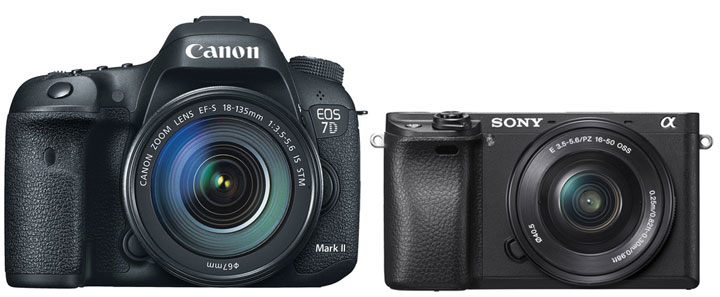 We have does a specification comparison as well as High ISO test between Sony A6300 vs Canon 7D Mark II camera. We have does a specification comparison as well as High ISO test between Sony A6300 vs Canon 7D Mark II camera.
Both the camera are totally different, Canon 7D Mark II built with a 20MP Dual pixel CMOS AF sensor, powered by Dual Digic 6 image processor and features a ISO range upto 512000 on the other hand the Sony A6300 features a newly developed CMOS Exmor sensor fabricated with 425 Phase AF points that gives you blazing fast AF speed during still and video shooting.
Before we jumop to any decision yet, let’s take a look at the specification chart and High ISO test images of both the camera.
| Features/ Models |
Sony A6300 |
Canon 7D Mark II |
| Megapixel |
24.2MP APS-C Exmor CMOS Sensor |
20.3MP APS-C X-Trans CMOS III Sensor |
| Sensor size |
23.5 x 15.6 mm |
22.4 x 15 mm |
| Sensor Type |
Hybrid CMOS AF |
Dual-Pixel CMOS Sensor |
| Low pass filter |
Yes |
No |
| Image processor |
BIONZ X Image Processor |
Dual DIGIC 6 Image Processors |
| AF system |
425 Phase-Detect Points and 169 contrast AF points |
65-Point All Cross-Type Phase-Detect AF |
| ISO |
100-51200 |
100-51200 |
| Shutter Type |
Electronic & Mechanical |
Electronic & Mechanical |
| Image Stabilization |
NO |
No |
| Shutter Min/ mix |
30 – 1/4000 |
30 – 1/8000 |
| Continuous shooting speed |
11 fps |
10 fps |
| Video |
Internal UHD 4K30 & 1080p120 Recording |
Full HD 1080p/60 Video & Movie Servo AF |
| Display |
3.0″ 921.6k-Dot Tilting LCD Monitor |
3.0″ 1.04m-Dot Clear View II LCD Monitor |
| Viewfinder |
XGA Tru-Finder 2.36m-Dot OLED EVF |
Advanced Hybrid Multi Viewfinder |
| Hot shoe |
Yes |
Yes |
| Wireless |
WiFi + NFC |
WiFi + NFC |
| Environmentally sealed |
No |
No |
| Battery life |
400 |
670 |
| Dimensions |
120.0 x 66.9 x 48.8 mm |
148.6 x 112.4 x 78.2 mm |
| Weight |
404 g |
910 g |
From the specification we can clearly see that Sony features bit more resoltuion as well as bit bigger sensor size. However despite of having almost same sensor size and ISO range the Sony A6300 is picking up more details during High ISO Test compared to Canon 7D Mark II camera.
The shutter range of the Canon 7D Mark II camera is borad compared to Sony A6300 as well as both of the camera almost have same continuous shooting speed.
The Major difference can be seen in the video section where we can see Canon 7d Mark II is limited to full HD video recording on the other hand the Sony A6300 can record 4k videos.
Now let’s have a look on the High ISO test samples.
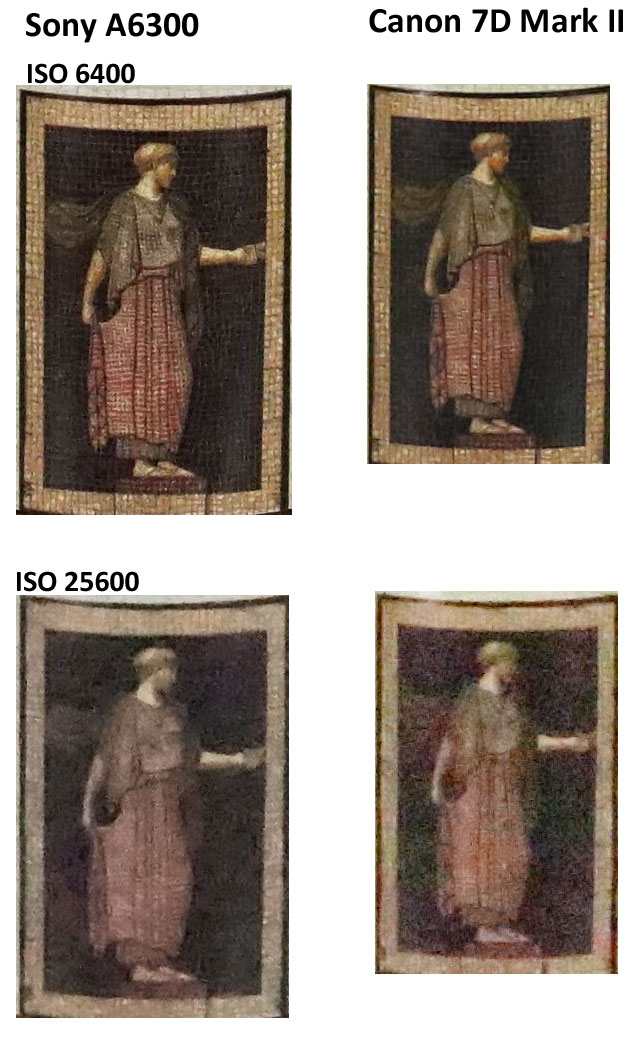 We don’t notice any major difference between the image quality of both the camera but we have to say we are noticing bit more details in the Sony A6300 image quality captured at ISO 6400. We don’t notice any major difference between the image quality of both the camera but we have to say we are noticing bit more details in the Sony A6300 image quality captured at ISO 6400.
The ISO 51200 image samples of both the camera is useless, I am not able to understand why companies unlock useless ISO stops, may be a just marketing thing.
At the end we have to say that Sony A6300 is a clear winner, if we look at the core specification of the camera the Sony offers you better AF system compared to Canon 7D Mark II camera as well as better image quality.
Thanks for reading the article I hope you enjoyed it, do share your thoughts with us
Canon 7D Mark II Best Lenses | Sony A6300 Recommended Lenses
High ISO Image Credit – imagineresource
|
KEEP THIS BLOG ALIVE - Support New Camera Buy Canon Lenses, Buy Music CD or Digital Camera at amazon it helps this site, and you do not pay anything extra, it is just a way to help support this site.

|




 We have selected Canon 760D with Pentax K-70 take a look at the specification comparison review of both the camera and do share your thoughts with us.
We have selected Canon 760D with Pentax K-70 take a look at the specification comparison review of both the camera and do share your thoughts with us.


 Which camera should you buy ? Canon 80D or Canon 6D ?, Well we have done a detailed specification comparison review with High ISO test, to fine out the best camera for you.
Which camera should you buy ? Canon 80D or Canon 6D ?, Well we have done a detailed specification comparison review with High ISO test, to fine out the best camera for you.








 We have does a specification comparison as well as High ISO test between Sony A6300 vs Canon 7D Mark II camera.
We have does a specification comparison as well as High ISO test between Sony A6300 vs Canon 7D Mark II camera. We don’t notice any major difference between the image quality of both the camera but we have to say we are noticing bit more details in the Sony A6300 image quality captured at ISO 6400.
We don’t notice any major difference between the image quality of both the camera but we have to say we are noticing bit more details in the Sony A6300 image quality captured at ISO 6400.



